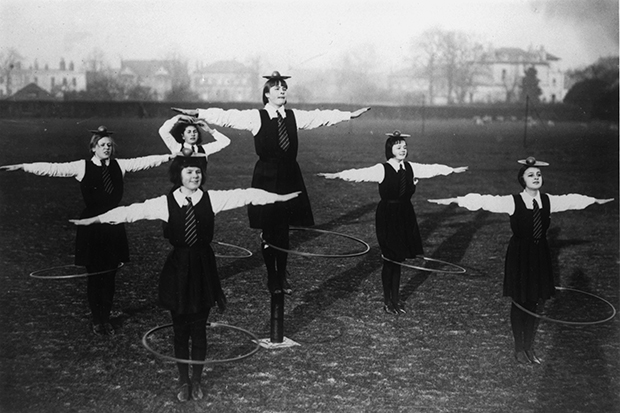I wonder if Cheltenham Ladies’ College is still like that,’ I thought, as I interviewed a succession of 1950s old girls recently. Their memories left me reeling, and I felt relieved not to have been a sensitive girl sent to Cheltenham from an outpost of the empire, condemned to spend seven years being hissed at in Gothic classrooms by sarcastic unmarried women. I still can’t decide whether I would have preferred to have had a terrifying time at Cheltenham in the Fifties but be -brilliantly taught, or have gone somewhere relaxed like Southover (which closed in 1988) and have a lovely time but learn nothing. Probably Cheltenham — but only just.
So last month I decided to find out if any of the old scariness remained. What I discovered was that it would be no fun writing a book about girls’ boarding schools in the 21st century: they are far, far too nice, happy and comfortable. I’ll take you through the chief memories of my 1950s old girls, and compare and contrast with How Cheltenham Ladies College Is Now.
‘There was a rule of absolute silence in the corridors. All the girls walked between lessons in total silence, and they looked as if they had rods up their backs.’
Today, the girls saunter along the corridors and one or two of them are so busy looking at their phones that they bump into you. Dragana Hartley (director of marketing and a 1960s old girl) told me very -quietly as we walked along the famous Marble Corridor that girls are now allowed to talk here, as long as they keep their voices down. The corridor is right next to the magnificent school library, she pointed out, so there’s a good reason for the keep-quiet rule.
‘The College looked like an intimidating cathedral: when you sat at your desk, the Gothic windows made Gothic-shaped shade-marks on your exercise books.’
Well, that’s still true. I glimpsed an open exercise book in the library and saw those very same reflections. The spirit of Dorothea Beale, visionary headmistress from 1858 to 1906, still oozes out of the Victorian -tracery. It was thanks to her that women’s education began to be taken seriously in the 19th century, and the college has always been a shining light in the world of women’s education. The Girton-like architecture is redolent of Miss Beale; but there are now modern blocks such as the new Fauconborg Wing, which contains the spanking-new Engineering, Enterprise and Technology Department.
‘For deportment purposes, regulation canvas sacks of books with leather handles had to be carried on the right shoulder on Mondays, Wednesdays and Fridays and on the left shoulder on Tuesdays, Thursdays and Saturdays.’ Just thinking about lugging those bags makes one feel exhausted. In those days the furthest boarding house was a 20-minute walk. Now the furthest is only ten minutes’ walk and girls can wear any backpack they like.
‘The first thing that struck me about the house was the lavatory tiles on the walls of the staircase.’
Boarding houses were chilly, unhomely and had lines on the bath to enforce an eight-inch high-water mark. Now they are warm, carpeted and almost hotel-like. St Helen’s House has a ‘Den’ where Saturday-night sleepovers are not only allowed but encouraged.
‘We had to go to our housemistress’s study one by one to say goodnight. You’d knock on the door and she would say, “Come!” Then she would say, “You haven’t come in the right way. Go out and do it again.” ’
The regulation ‘goodnight’ to those terrifyingly unmotherly housemistresses was a nightly ordeal. Today I am shown round St Helen’s by the young and delightful Mrs Nestor-Powell, who has a husband and two children. About the only rule in the house is ‘No showering during prep’. I did glimpse a bin of lacrosse-sticks in the downstairs boot room, however, which gave me a bit of a 1950s frisson. Most girls love lacrosse, said Mrs Nestor-Powell and there is pilates, zumba or badminton too.
‘There was a map in College showing which roads you were allowed to walk along. The streets marked in green were permitted; the streets marked in red were out of bounds: those were the streets the boys from the boys’ college were allowed to walk on.’
Never, in the 1950s, must a girl so much as glimpse a boy. Cheltenham old girls knew the rules in detail and would report anyone straying to an out-of-bounds street. Today it’s fine to have coffee with pupils from the boys’ schools in your free time and there are inter-school ‘socials’. ‘The relationship between the staff and the girls is built on trust,’ said Mrs Roca-Aguilera, the friendly housemistress of St Hilda’s, a sixth-form house.
‘Friday lunch was brown whale meat with thick white sinews… the knives and forks still smelled of the herrings we’d had for supper the night before.’
I had lunch at St Hilda’s with Rebecca and Anna, both doing -sciences and maths A-levels (sixth-formers can wear trousers. Trousers! Unheard of in the itchy gym-slip olden days.) Painted on the wall are the words: ‘The St Hilda’s kitchen: serving up memories since 1885.’ Today’s served-up memories are happier than those of my 1950s old girls: we had poached -salmon with rice and sugar-snap peas, then cheese and biscuits.
‘The day-girls were seen as the pits!’
The few day-girls were treated as third-class citizens: their house was at the very bottom on the kudos scale. Nowadays there are 180 day-girls out of 850 girls (from 40 different countries), and they are valued members of society, rather than ‘the dregs’.
A fundamental change is in pastoral care. A 1950s girl was left to sink or swim with barely any help from the housemistress. Now, since the launch of a new wellbeing programme last September, the whole school stops each Friday before lunch to devote 50 minutes to thinking about mindfulness and how to deal with stress.






Comments